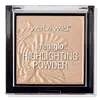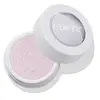What's inside
What's inside
 Key Ingredients
Key Ingredients

 Benefits
Benefits

No benefits
 Concerns
Concerns

 Ingredients Side-by-side
Ingredients Side-by-side

Synthetic Fluorphlogopite
Dimethicone
EmollientBoron Nitride
AbsorbentOctyldodecyl Stearoyl Stearate
EmollientTrimethylsiloxysilicate
EmollientNylon-12
Ethyl Macadamiate
Skin ConditioningPolysorbate 20
EmulsifyingPhytosteryl Macadamiate
Skin ConditioningMagnesium Aluminum Silicate
AbsorbentCaprylic/Capric Triglyceride
MaskingPhenoxyethanol
PreservativeSorbitan Stearate
EmulsifyingCaprylyl Glycol
EmollientTin Oxide
AbrasiveHexylene Glycol
EmulsifyingEthylhexylglycerin
Skin ConditioningWater
Skin ConditioningSilica
AbrasiveO-Cymen-5-Ol
AntimicrobialPolyacrylamide
Tocopheryl Acetate
AntioxidantLauroyl Lysine
Skin ConditioningC13-14 Isoparaffin
EmollientLaureth-7
EmulsifyingTriethoxycaprylylsilane
Tocopherol
AntioxidantTitanium Dioxide
Cosmetic ColorantMica
Cosmetic ColorantIron Oxides
CI 77492
Cosmetic ColorantCI 77499
Cosmetic ColorantCI 75470
Cosmetic ColorantCI 77510
Cosmetic ColorantSynthetic Fluorphlogopite, Dimethicone, Boron Nitride, Octyldodecyl Stearoyl Stearate, Trimethylsiloxysilicate, Nylon-12, Ethyl Macadamiate, Polysorbate 20, Phytosteryl Macadamiate, Magnesium Aluminum Silicate, Caprylic/Capric Triglyceride, Phenoxyethanol, Sorbitan Stearate, Caprylyl Glycol, Tin Oxide, Hexylene Glycol, Ethylhexylglycerin, Water, Silica, O-Cymen-5-Ol, Polyacrylamide, Tocopheryl Acetate, Lauroyl Lysine, C13-14 Isoparaffin, Laureth-7, Triethoxycaprylylsilane, Tocopherol, Titanium Dioxide, Mica, Iron Oxides, CI 77492, CI 77499, CI 75470, CI 77510
Dimethicone
EmollientIsononyl Isononanoate
EmollientTrimethylsiloxysilicate
EmollientDimethicone Crosspolymer
Emulsion StabilisingEthylhexyl Isononanoate
EmollientSilica
AbrasiveVinyl Dimethicone/Methicone Silsesquioxane Crosspolymer
Isopropyl Myristate
EmollientPhenoxyethanol
PreservativeStearalkonium Hectorite
Gel FormingEthylhexylglycerin
Skin ConditioningSynthetic Fluorphlogopite
Propylene Carbonate
SolventCI 75470
Cosmetic ColorantCI 77510
Cosmetic ColorantMica
Cosmetic ColorantCI 77891
Cosmetic ColorantDimethicone, Isononyl Isononanoate, Trimethylsiloxysilicate, Dimethicone Crosspolymer, Ethylhexyl Isononanoate, Silica, Vinyl Dimethicone/Methicone Silsesquioxane Crosspolymer, Isopropyl Myristate, Phenoxyethanol, Stearalkonium Hectorite, Ethylhexylglycerin, Synthetic Fluorphlogopite, Propylene Carbonate, CI 75470, CI 77510, Mica, CI 77891
Ingredients Explained
These ingredients are found in both products.
Ingredients higher up in an ingredient list are typically present in a larger amount.
Ci 75470 is a bright-red pigment. It is AKA carmine.
Carmine is derived from insects such as the cochineal beetle. This ingredient has been used as a natural dye for over 2000 years.
This ingredient is used to impart a blue color. It is not water-soluble.
It goes by two different names:
1. Ferric Ferrocyanide: a synthetic dark blue pigment
2. Ferric Ammonium Ferrocyanide: a synthetic blue pigment, also called Prussian blue
In the EU, both of these colors must be labeled as 'CI 77510'.
Learn more about CI 77510Dimethicone is a type of synthetic silicone created from natural materials such as quartz.
What it does:
Dimethicone comes in different viscosities:
Depending on the viscosity, dimethicone has different properties.
Ingredients lists don't always show which type is used, so we recommend reaching out to the brand if you have questions about the viscosity.
This ingredient is unlikely to cause irritation because it does not get absorbed into skin. However, people with silicone allergies should be careful about using this ingredient.
Note: Dimethicone may contribute to pilling. This is because it is not oil or water soluble, so pilling may occur when layered with products. When mixed with heavy oils in a formula, the outcome is also quite greasy.
Learn more about DimethiconeEthylhexylglycerin (we can't pronounce this either) is commonly used as a preservative and skin softener. It is derived from glyceryl.
You might see Ethylhexylglycerin often paired with other preservatives such as phenoxyethanol. Ethylhexylglycerin has been found to increase the effectiveness of these other preservatives.
Mica is a naturally occurring mineral used to add shimmer and color in cosmetics. It can also help improve the texture of a product or give it an opaque, white/silver color.
Serecite is the name for very fine but ragged grains of mica.
This ingredient is often coated with metal oxides like titanium dioxide. Trace amounts of heavy metals may be found in mica, but these metals are not harmful in our personal products.
Mica has been used since prehistoric times throughout the world. Ancient Egyptian, Indian, Greek, Roman, Aztec, and Chinese civilizations have used mica.
Learn more about MicaPhenoxyethanol is a preservative that has germicide, antimicrobial, and aromatic properties. Studies show that phenoxyethanol can prevent microbial growth. By itself, it has a scent that is similar to that of a rose.
It's often used in formulations along with Caprylyl Glycol to preserve the shelf life of products.
Silica, also known as silicon dioxide, is a naturally occurring mineral. It is used as a fine, spherical, and porous powder in cosmetics.
Though it has exfoliant properties, the function of silica varies depending on the product.
The unique structure of silica enhances the spreadability and adds smoothness, making it a great texture enhancer.
It is also used as an active carrier, emulsifier, and mattifier due to its ability to absorb excess oil.
In some products, tiny microneedles called spicules are made from silica or hydrolyzed sponge. When you rub them in, they lightly polish away dead skin layers and enhance the penetration of active ingredients.
Learn more about SilicaSynthetic Fluorphlogopite is the synthethic version of mica. It consists of fluorine, aluminum and silicate.
Synthetic Fluorphlogopite is used to add volume to products.
It is considered non-irritating on the skin.
Learn more about Synthetic FluorphlogopiteThis silicone is an emollient. Emollients create a thin film on the skin to prevent moisture from escaping.
It is not soluble in water and helps increase water-resistance in products.
According to a manufacturer, it can blend seamlessly with silicone oils, such as Cyclopentasiloxane.
Learn more about Trimethylsiloxysilicate